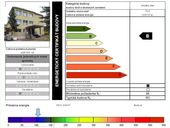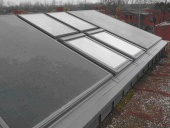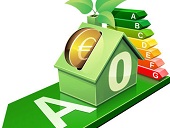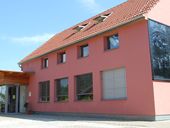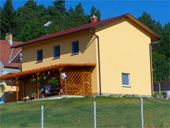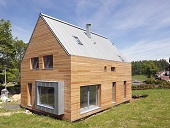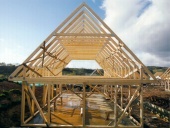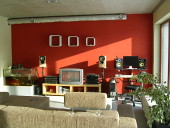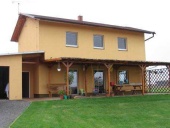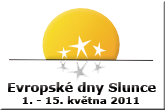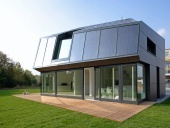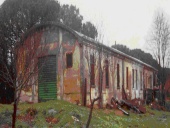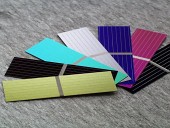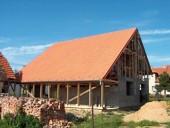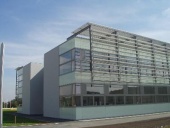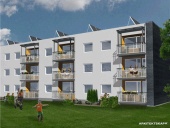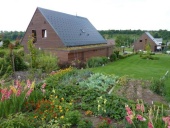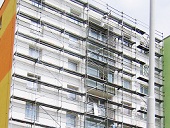The last revision of STN 73 0540 came in the validity in 2002. The requirement on minimum energy performance of buildings influenced heat need for heating by decreasing of 28.6 % comparing with the requirement of valid standard. The recast of the directive issued as directive 2010/31/EU required further decreasing of energy use for heating. To achieve the required stage in energy performance of buildings also changes in thermal protection properties are needed.
Archiv článků od 7.3.2011 do 12.9.2011
Comparison of knowledge in the field of wooden buildings between the CR and abroad is especially based on the author's many foreign visitors of completed buildings, businesses and universities, the knowledge of the extent and quality of especially American and German literature and participation in many international conferences, including the last World Congress of timber engineering WCTE, held in June 2010 in Italy.
Nowadays there is a growing interest in quality and high energy saving housing. The following article presents the almost unusual renovation of a terraced building in Denmark. It was expected that after the renovation the building with become CO2 neutral. The last house of a terrace in the twon of Albertslund, Denmakr was chosen for the renovation. It had been built in the 1960's and it is a two story terraced house with a 50m2 footprint.
The article provides information on the activities of the International Centre AIVC (Air Infiltration and Ventilation Centre), which in a new cycle from 2011 to 2013 will focus on the strategy 20-20-20, which oblige EU countries to save energy in buildings. The article explains the structure of the AIVC and its tasks as an international information center, to help not only the AIVC member countries in addressing ventilation in newly built buildings that will have to meet very strict requirements for tightness.
In January I published an article about the upcoming revision of CSN 73 0540-2 Thermal protection of buildings, Part 2: Requirements. I expressed to changes in each individual chapter. Since then there is new development in the standard revision. Some comments by members of the Standardisation Committee No. 43 and by professionals from the April public consultation of the standard were implemented. Some chapters of the standard are nearly unchanged since January, but some have changed in fairly major way.
Much has been written about this Moravian Village at the foot of the White Carpathian Mountains. It is renown for its environmental projects, it has been visited by many prominent personalities and it is considered an example of energy saving and environmental construction. This time, we have focused on a passive house that works as a model of environmental projects in rural areas.
The construction of a family house in a quiet spot in a village is a common request that should not surprise anyone. In the village of Mylsejovice, located in the Olomouc Region at 353m above sea level, there is an interestingly designed low energy house that has dealt with the use of the chimney, among other things. Originally, the owner didn't have in mind a passive house. The final measurements pleasantly surprised him.
Our serial continues with this low-energy house built with sand-lime bricks. This time, the family house is located not far from Liberec, in the foothills of the Jizera mountains. The surroundings, predominantly rural houses near a protected natural area, influenced the shape of the house. Its location responds primarily to the surrounding buildings and the slightly sloping land.
The less the knowledge, the better the (shown) results.“ This proverb should never be applied in Civil Engineering works, not even in the field of energy calculations of a building. The technical documentations should provide clear evaluation guidelines and, whenever possible, plenty of straightforward information. Thanks to the subsidy programs of the Czech Republic, which are finally being applied to passive buildings, the issue of energy calculations has suddenly become important for planners and the administrators of the programs. Refining the definition of zero-energy buildings will be a key issue in the near future. Zero energy buildings should be understood as a logical continuation of passive buildings, a reasonable addition to active energy components.
While in Germany and Austria this kind of buildings are already a common sight, in the Czech Republic it was celebrated as a local pioneer. The calcium and sand structure with a gabled roof supported by glass rubble, which was certified by the Passivhausinstitut Dr Wofgang Feist y Darmstadt, has passed a wide range of technical measurements and numerous visits. We attended one of them.
Even though the use of skylight windows in passive houses is questionable, sometimes it can not be avoided. The increase in the number of energy efficient buildings has lead to an increase in the range of products aimed at this type of constructions. On our market there are several manufacturers that offer windows for passive buildings. Usually they are standard triple-glazed skylights supplemented by a so called thermal kit. If a manufacturer presents other parameters than just the value of the Ug coefficient of glazing, a lot of optimism will be needed for that to be believed. However, the underlying problems of the use of skylight windows in passive buildings will still remain.
The European Solar Days successfully promote the use of a free unlimited renewable energy source available everywhere to everyone to generate electricity as well as heating and cooling: the SUN.
This campaign raises public awareness and involves several hundred thousand citizens at local level. Pioneer countries such as Austria, Germany, Switzerland, as well as others that successfully embraced this initiative like France, Italy and Spain, are only too keen to share their experience and help spread the word. The European Solar Days are celebrated in an increasing number of countries and in 2010 around 6.600 events were planned in 17 European countries by diverse organisations ranging from solar equipment manufacturers to schools and local authorities.
The higher insulations standards for windows used in the construction of passive houses usually result in lower energy permeability of the glazing. Whether it is more efficient the use of triple or double glazing will depend on the orientation and shading of the windows, and will also be related to the characteristics of the whole building and the way it is used, specially the size of the internal gains. A study conducted on groups of apartment buildings, using multiple simulations, evaluates the impact of the properties of the glazing and the resulting heating needs for various conditions of shading, insulation and size of the internal gains.
In 2007 the group GAIA SpA got an idea from Massimo Fiorini (an amateur builder) to reconstruct the delapidated Marconi Laboratories in Coltrano, near Pisa (Italy) and turn it into EneryPlus terraced passive houses. The group was fully convinced after a visit to the ASSA passive office building in Santa Croce Sull'Arno, and in 2008 they began the design works. The building turned out to be appropriate to be turned into a passive house project. However, the problem was listed in the highest heritage class, which had been granted not for the importance of the building itself, but as part of a listed group. The planning had to be very detailed. Another problem was the arched concrete roof, which was extremely vulnerable to collapse. The Heritage Protection Office in Pisa was at first very sceptical with the project, but in the end they were convinced about the interest and the quality of the project after a series of meetings with the builders and the representatives of TBZ.
Coloured photovoltaic cells are occasionally used in architectural applications. Their wider utilisation is currently limited by the lower efficiency compared to cells with an optimal anti-reflective coating. Research is focused on desing and manufacturing of anti-reflective coating, which besides of required color will have minimised the reflection in the infrared.
There’s still big potential to make building cheaper, including building of passive houses. If the passive house building is optimalised and uncomplicated, It can be much cheaper than classic building. This paper analyses the building of family passive house in the Czech Republic step by step by the author himself.
Over 5000 buildings in Austria have been constructed in the passive standard. In the future, a considerable part of new constructions should be build in the passive standard. The goal is to have all subsidised residential buildings built in the passive standard by 2015. The aim of the study was to learn from the first residential complexes of passive buildings. The main questions were: Do the passive buildings meet the ambitious expetations of the project? How satisfied are the people living in them? What additional construction costs can be expected and what are the actual energy savings compared to conventional residential complexes?
As in other countries, in Norway energy remediation is carried out mostly on an average level. For a decade, this has blocked highly effective energy saving measures in public housing because better energy remediation measures pay off only after a long time. Myhrerenga is the first block of flats in Norway renovated according a passive house concept.
Low energy (LEB) and passive buildings (PB) are becoming standard for new constructions in EU countries. They aren't experiments anymore, but absolutely ordinary mass production of sophisticated residential buildings. Only in Germany, Austria and Switzerland there are already thousands of buildings that meet the passive standard and their number doubles every year. The cost of passive buildings is only 5-7 % higher than those of conventional ones, and yet, their consumption of energy and heating is up to 90 % lower! Part 4 about circulation system air heating system with a controlled proportion of ventilation air and heat recovery, and some design principles for design and ventilation NED EPD.
The article describes some of the results of the research project R&D SP3g522107 – Full renovation of panel buildings in the low energy standard, which was carried out by EkoWATT with the support of the Ministry of the Environment in the years 2007-2010. One of the main instruments described is the parametric model, which allows the evaluation of a large sample of virtually generated building probabilistic methods, a case study of a renovation of a panel building to a passive standard using a grant with a 8 year investment return and also, an internet application that easily allows to add a panel building to a computer model and test the effects of the saving measures.
zpět na aktuální články
